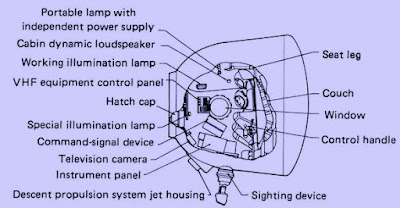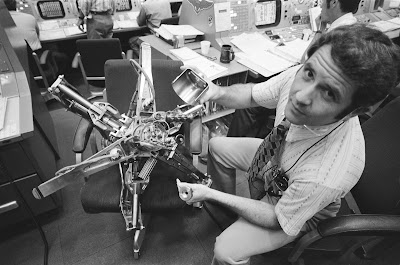Apollo- Soyuz, as I lived it a half century ago Pt4
HAND-SHAKE
Thursday, July
17, 1975, was the historic day when a Soviet spacecraft would link up with an
American spacecraft. I was lucky enough to be working an early morning
half-shift that finished at 11:00 and gave me plenty of time to get home and
watch the event. The networks were on the air starting at noon in an all-out
effort to cover this rendezvous and docking.
In the late 1960s to early 1970s even the most rabid civilian space buff in the free world knew very little about the Soyuz and the Soviets were quite happy to keep it that way. Now, thanks to the Apollo Soyuz Test Project, that was all changed.
Soyuz consisted of three modules...
...a service module like Instrument-Assembly Module...
...a Reentry Module...
...and an Orbital Module.
One stand-out feature of Soyuz was that it operated by getting much of its electrical power from solar panels, rather than Apollo which used fuel cells.
Now, we western space-buffs were going to get to see the inside of Soyuz on live TV.
Indeed, the
whole world was watching. Presidents, First Secretaries, diplomats, reporters,
spies, generals and just regular slobs like me were all watching the docking.
Oddly, it was only the space-buffs who were
scratching their heads and asking, “What’s the point?” Why was it that
exploration and science in space was considered to not be newsworthy, but a common rendezvous and docking, something that the
United States had been doing since 1966, was now hot global news? Indeed, we space-buffs thought that, but we still watched.
Soyuz was the
passive vehicle in the rendezvous and Apollo was the active spacecraft. As the
rendezvous proceeded, the people involved spoke to the people from the other
country in that country’s language. Thus, Stafford spoke to Leonov in Russian
and Leonov spoke to Stafford in English. It was a bit strange because when
Stafford spoke a Russian translator took what the astronaut was saying and gave
it to the U.S. audience in English with a Russian accent. Of course, the same
was true for Leonov, only the Soviet public probably got an Oklahoma accent.
As the two
spacecraft captured in a hard dock Leonov sang out that Soyuz and Apollo were
“shaking hands.” We saw cut-away video of the space centers in Russia and the
United States with controllers standing and applauding. At that moment my
thoughts were of Deke Slayton. Even as a 17-year-old I knew what he had been
through. He had been forced to sit in Mission Control for more than two dozen
dockings in space while wishing he had been on every one of them. This time it
was everyone else in Mission Control watching him. It is rare that a very large
wrong is made right in such a public way. I wondered how many of those people
in Mission Control were applauding as much for Deke as they were for ASTP.
Docking was achieved by way of an androgynous docking collar attached to the Soyuz and the forward end of the DM. The aft end of the DM had the standard Apollo drogue/probe unit.
The probe in CM 111 was actually the same probe that was used on Apollo 14. Normally, Apollo CM vehicles jettisoned their probe with the Lunar Module's ascent stage. Because Apollo 14 was the first mission to have problems with docking capture on the way to the Moon, NASA had their probe mechanism retained and returned for engineers to study in order to seek out what the problem may have been. They found nothing, so the probe was reused for ASTP.
Other than the docking adapter, the only other new piece of spaceflight hardware for ASTP was the DM. It was required because the Apollo CM started on the pad with a sea-level atmosphere which was a nitrogen-oxygen mixture. As the Saturn booster ascended, that cabin was vented down to 1/3 sea level, pure oxygen. This was a direct result of the Apollo 1 fire which was fueled by pressurized pure oxygen. The Soyuz, however, flew with sea level nitrogen/oxygen atmosphere. If the Apollo astronauts had been exposed to that, they would be forced to spend a long period after each exposure slowly purging nitrogen from their blood to avoid something similar to "the bends." Thus, the Soviets also agreed to reduce the Soyuz atmosphere to just 2/3 sea level. The DM allowed the crews to make the transition in an air-lock environment that was good for both sides. The DM was designed and constructed by Rockwell International Space Division.
Three hours and
five minutes after the capture, Stafford and Slayton in the DM, closed the hatch to Apollo and allowed the atmospheres to adjust, then opened the hatch
to Soyuz on live TV. In the distance through the adjacent tunnel we could see the two
cosmonauts moving inside the Orbital Module (OM) of the Soyuz. There was a communications glitch
that would haunt the entire duration of the docked activities and we could not
hear the cosmonauts speaking at first. After a short delay, Leonov floated into
the tunnel and he and Stafford shook hands in a very contrived manner as they
exchanged happy greetings that gave you the impression that the words were
printed on a note card. A moment later Slayton also floated into the camera’s
view and shook Leonov’s hand. It was all highly symbolic, well scripted and
made for the cameras.
Eventually
Stafford floated through the tunnel and into the Soyuz OM. And then the TV
switched from the American feed to the Soviet feed from the repaired equipment
aboard Soyuz. The Russian ground technician who had installed
that camera must have sighed with relief; there would probably be no trip to
the salt mines for him. He may simply be reassigned to polishing railroad rails
for a living.












No comments:
Post a Comment